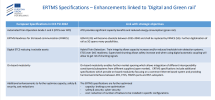DerekC
Established Member
I see that the Class 700s are to get an ERTMS upgrade:
https://www.networkrailmediacentre....leet will be,the East Coast Digital Programme.
https://www.networkrailmediacentre....leet will be,the East Coast Digital Programme.
These trains were fitted with ETCS and and ATO from the start. The ETCS infrastructure was commissioned a few years ago (I forget the date) with a considerable ta-ra. The upgrade will be to make the trains compatible with the latest version of ETCS on the ECML. Is ETCS and ATO in regular use in the Thameslink core?Thameslink fleet set for additional digital upgrade
Region & Route: Eastern
Industry partners in the transformational East Coast Digital Programme (ECDP) have signed a £32.7million contract to upgrade the Class 700 Thameslink fleet to the latest specification of European Train Control System (ETCS). The five-year contract was signed by Cross London Trains, DfT, Govia Thameslink Railway, Network Rail and Siemens Mobility.
The 115-strong Thameslink fleet is the largest passenger fleet in a programme designed to replace conventional signals at the side of the track with state-of-the-art digital signalling - providing continuous, real-time information to the driver’s cab.
The technology will mean more reliable and greener services for passengers and freight, creating the next generation railway.
Coupled with the retrofit of ETCS to Great Northern’s Class 387 Electrostars [see past press release] and the wider ECDP fleet fitment programme, the Class 700 upgrade will help unlock the potential for the remarkable benefits of digital signalling to be rolled out to other parts of the UK network


